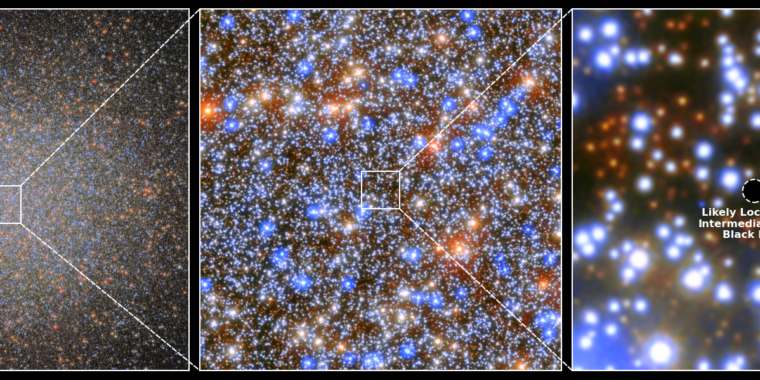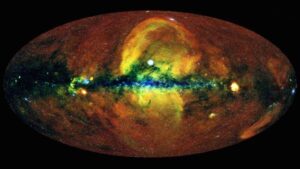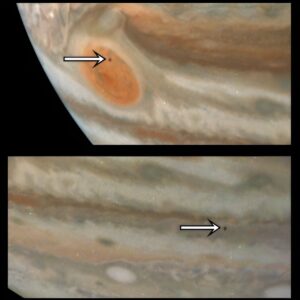ESA/Hubble & NASA, M. Häberle
Supermassive black holes appear to reside at the center of every galaxy, and have done so since galaxies formed early in the universe’s history. However, we currently cannot fully explain their existence, as it is difficult to understand how they could grow fast enough to reach the supermassive limit as quickly as they did.
One possible piece of evidence was recently found using about 20 years of data from the Hubble Space Telescope. The data comes from a globular cluster of stars believed to be the remnants of a dwarf galaxy, and shows that a group of stars near the cluster’s core are moving so fast that they should have been ejected from it entirely. This suggests that something massive is holding them there, which the researchers say is a rare medium-mass black hole weighing more than 8,000 times the mass of the Sun.
Move fast
The fast-moving stars are found in Omega Centauri, the largest globular cluster in the Milky Way. With approximately 10 million stars, it’s a crowded environment, but observations are aided by its relative proximity, “only” 17,000 light-years away. These observations hint that there may be a central black hole in the globular cluster, but the evidence is inconclusive.
The new work, carried out by a large international team, used over 500 images of Omega Centauri taken by the Hubble Space Telescope over 20 years. This allowed them to track the motion of the stars in the cluster, allowing an estimate of their velocity relative to the cluster’s center of mass. Although this has been done before, the latest data allowed for an update that reduced the uncertainty in the stars’ velocities.
Within the updated data, a number of stars near the center of the cluster stood out for their extreme velocities: seven of them were moving fast enough that the cluster’s gravitational pull was not enough to keep them there. All seven should be lost from the cluster within 1,000 years, although uncertainty remains large for two of them. Based on the size of the cluster, there shouldn’t even be a single foreground star between Hubble and the Omega cluster, so they do appear to be in the cluster despite their speed.
The simplest explanation for this is that there is extra mass holding them in place. These could potentially be several massive objects, but the close proximity of all these stars to the cluster center favors a single, compact object. Which means black hole.
Based on the velocities, the researchers estimate that the mass of the object is at least 8,200 times that of the Sun. Several stars appear to be accelerating; if this holds up based on additional observations, it would mean the black hole is over 20,000 solar masses. This puts it firmly in black hole territory, albeit smaller than supermassive black holes, which are considered to be roughly one million solar masses or more. And it’s significantly larger than you’d expect from black holes formed by the death of a star, which aren’t expected to be much larger than 100 times the mass of the Sun.
This puts it in the category of intermediate-mass black holes, of which there are only a few potential observations, none of which are universally accepted. So this is a significant discovery, if for no other reason than that it may be the least controversial sighting of an intermediate-mass black hole to date.
What does this tell us?
For now, there is still considerable uncertainty in some of the details here, but there are prospects for the situation to improve. Observations with the Webb Space Telescope could potentially pick up faint emissions from gas falling into the black hole. And it can track the seven stars identified here. Its spectrographs could also potentially pick up the red and blue changes in light caused by the star’s motion. Its location at a significant distance from Hubble could also provide a more detailed three-dimensional picture of the central structure of Omega Centauri.
Realizing this could potentially tell us more about how black holes grow to supermassive scales. Earlier potential observations of intermediate-mass black holes also came in globular clusters, which may suggest that they are a common feature of large star clusters.
But Omega Centauri differs from many other globular clusters, which often contain large populations of stars that all formed around the same time, suggesting the clusters formed from one giant cloud of material. Omega Centauri has stars with a wide range of ages, which is one reason people think it’s the remnants of a dwarf galaxy that was sucked into the Milky Way.
If so, then its central black hole is analogous to the supermassive black holes found in actual dwarf galaxies—which begs the question of why it is only intermediate-mass. Did something in its interaction with the Milky Way prevent the black hole from growing?
And ultimately, none of this sheds light on how any black hole becomes much more massive than any star it could have formed from. Gaining a better understanding of the history of this black hole could provide a better perspective on some questions currently troubling astronomers.
Nature, 2024. DOI: 10.1038/s41586-024-07511-z (About DOI).



